Realizing learn how to steadiness your radiators could stop extra cash than you suppose – and we’ve acquired the lowdown on what that truly means.
The considered balancing radiators might conjure up pictures of wonky radiators sitting off-centre in your partitions, nevertheless it absolutely’s far more technical than that. This household course of should be part of the widespread repairs of your central heating system.
Uneven radiator effectivity can go away some rooms feeling toasty whereas others keep uncomfortably cool. If this sounds acquainted, it might be time to steadiness your radiators. Balancing ensures that scorching water flows evenly all by way of your heating system, making every nook of your property equally inviting.
Nevertheless few people know why or learn how to steadiness radiators, which suggests they’re missing out on a quick and easy resolution to avoid wasting energy. That’s why we requested the specialists for all the data you possibly can discover out about this necessary repairs course of to keep up your property warmth this winter.
The perfect half? It appears you don’t must be a plumbing educated to get it correct, primarily based on our specialists. With this step-by-step and barely endurance, it’s possible you’ll get your radiators heating your individual house evenly, all by your self.
Learn the way to steadiness radiators
‘In a nutshell, balancing your radiators is everytime you’re attempting to get your radiators to all heat up on the similar price, whether or not or not being furthest away from the boiler or closest,’ explains Nicholas Auckland, heating educated at Commerce Radiators.
And as working your heating for merely an hour a day will most likely be going up in worth; it’s further crucial than ever to guarantee that your radiators are balanced.
Why do you must steadiness your radiators?
Alongside checking your radiators heat up and flushing your radiators, in the event you want to assure your central heating system is working simply and your individual house is as energy-efficient as potential, balancing your radiators is important.
The thought behind this a lot much less typically recognized household course of is that by adjusting the valves in your radiator, it’s possible you’ll administration the flow into of scorching water out of your boiler to verify an excellent heat distribution.
So, if one among your radiators takes longer to heat up than others, it’s possible you’ll enhance the flow into of scorching water to warmth it up sooner whereas reducing the flow into to radiators that heat up shortly.
So checking off this course of could even most likely reduce the price to run your central heating system. ‘Balancing your central heating system not solely improves comfort however as well as helps you get financial financial savings on heating funds,’ explains Nicholas.
‘An unbalanced system might trigger your boiler to work extra sturdy than necessary, leading to bigger energy utilization and higher funds.’
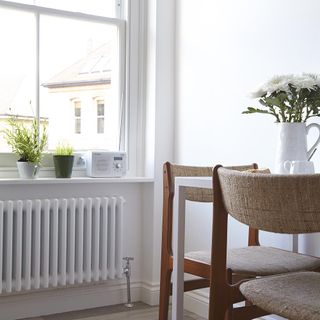
(Image credit score rating: Future PLC/David Parmiter)
What happens in case your radiators aren’t balanced?
‘In case your radiators are unbalanced, they could heat up at completely totally different speeds in a number of areas of your property,’ says Nicholas. ‘Which suggests certain components of your property will take longer to warmth up, and significantly all through chilly winter months, this can be irritating.’
The truth is, this moreover implies that you simply’ll should keep your heating on for longer in the event you want to warmth up certain rooms within the house. This could lastly result in wasted energy and money as you’ll keep pumping heat into rooms which is likely to be already on the optimum temperature.
Lastly, you could just be sure you’re heating your property as successfully as potential. Unbalanced radiators don’t allow for such effectivity, though, so it’s best to deal with unbalanced radiators as rapidly as you discover the symptoms.
A simple confirm might be to walk spherical your individual house, evaluating your radiators in direction of each other. In case you wanted to, you may even use a thermometer to be as precise as potential.
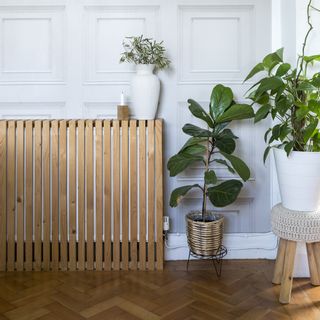
(Image credit score rating: Future)
What you’ll need
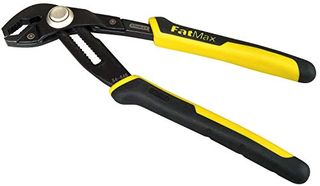
Stanley Fatmax Multigrip Groove Joint Pliers
Select up a pair of pliers (say that shortly) for the finicky job of balancing radiators. They are going to turn into helpful everytime you’re tightening up any unfastened valves.
Learn the way to steadiness radiators – step-by-step
You’ll be joyful to know that you simply simply don’t should spend your hard-earned money on hiring a plumber to steadiness your radiators. Whereas it’s a extended course of, it’s fairly easy to do at home in case you observe this step-by-step info.
1. Gather the suitable devices
To get the job completed merely, you will have the suitable devices they often’re very simple to pick out up.
‘Balancing your radiators will likely be completed as a DIY course of. With the suitable instructions, a couple of major devices (like small spanners or pliers for the valves, and a reliable strategy of measuring temperature variations -e.g. A digital thermostat), most house owners can steadiness their system themselves,’ says Rob Nezard, Managing Director of UKRadiators.com.
Get your self an adjustable spanner or pliers – like these STANLEY FATMAX Multigrip Groove Joint Pliers from Amazon, a flathead screwdriver – like this Magnusson Customary Flat head Screwdriver from B&Qa radiator bleed key – like this WZ Radiator Bleed Key from Amazon, a digital thermometer – like this Inrigorous Black Digital Steel Thermometer from Amazon and some earlier towels.
2. Flip off your heating
Whereas balancing your radiators should result in scorching radiators all through the board, the very final thing you could do is tinker alongside along with your radiators whereas they’re scorching. So, it’s terribly crucial to point out off your heating sooner than starting this course of. You additionally wants to provide them ample time to relax down completely, too.
When you’ve completed that, seize some earlier towels and place them spherical your radiators.
2. Bleed your radiators
There’s no degree balancing radiators which is likely to be already in need of some TLC – significantly in case your radiator is making weird noises. So, it’s best to offer them the attention they deserve sooner than transferring on to the next step.
‘Use a radiator key to bleed each radiator to launch any trapped air. Start with the radiator closest to the boiler and work your strategy spherical the house. This ensures the system has no air pockets, which can affect the balancing course of,’ explains Nick Duggan, Managing Director, The Radiator Centre.
‘In case you seen that some radiators are solely heating up on the bottom, then it’s a good suggestion to launch any trapped air from the radiators to restore this draw back,’ supplies Nicholas.
We gained’t go into an extreme quantity of factor about how to do that now, as our easy step-by-step info on learn how to bleed radiators should make this a doddle. Merely you’ll want to have some earlier towels helpful.
3. Open up all radiator valves
The next step is to open up all of the valves on the radiators in your own home. ‘This ensures an unrestricted place to start,’ explains Rob Nezard, Managing Director of UKRadiators.com.
An anti-clockwise flip can try this, and whenever you’ve obtained thermostatic valves or wheel head valves, you could be able to do it by hand.
Once you’ve obtained lockshield valves (the valves which have plastic covers on prime), you’ll should take away the plastic cowl after which use an adjustable spanner to point out it anti-clockwise.
‘Completely opening the valves permits water to flow into freely as a kick off point,’ says Nick.
4. Flip your heat on as soon as extra
A bit endurance and a companion will help you full the next step. That’s because you then wish to present your heating once more on and make a note of how prolonged all of your radiators take to heat up.
It’s best to have one other particular person help you with this, and it’s an excellent suggestion to have any individual type out the underside floor of your individual house and one different particular person type out the very best floor.
‘Discover the order by which the radiators warmth up. Radiators closest to the boiler typically heat first,’ explains Rob.
5. Flip the heating on and off as soon as extra
When that’s completed, you could know which radiators in your individual house need turning all the way in which right down to steadiness the rest of the house. And whereas it would sound counterintuitive, you then wish to exhibit your heating and let your radiators cool totally.
As quickly as that’s completed, flip your heating once more on and head to the radiator that heated up the quickest as rapidly as potential.
6. Stability the quickest radiator
To steadiness this radiator, completely shut the lockshield valve sooner than opening it a quarter-turn. Sooner than too prolonged, you’ll actually really feel it heat up – and in addition you’ll moreover uncover the next radiator get hotter, too. That’s because of this course of ought to help to push the flow into of scorching water to the next radiator in line.
‘Starting with the radiator closest to the boiler, step-by-step shut its lockshield valve (the valve usually coated with a defending cap) until you get hold of a useful temperature distinction between the radiator’s inlet and outlet pipes (often spherical a 10-12°C drop),’ explains Rob. ‘Work methodically through each radiator in flip.’
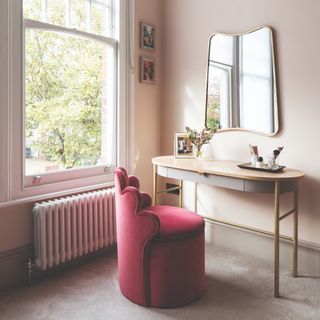
(Image credit score rating: Future PLC/James French)
7. Take a look at the temperature
When it’s possible you’ll actually really feel the quickest radiator has heated up completely, you possibly can seize your digital thermometer and take two completely totally different readings.
First, you possibly can take the temperature of the pipework near the lockshield valve. Then, you possibly can take the temperature on the other facet of the radiator, by the pipework near the thermostatic valve. In a wonderful world, the excellence between these two pipes should be 12°c exactly – nonetheless it is attainable you will should open or shut the lockshield valve barely until you attain this desired temperature distinction.
This 12°c distinction is awfully crucial, as a result of it’s thought-about to be basically essentially the most energy-efficient amount. By preserving it at 12°c, it’s possible you’ll ensure that the radiator will get warmth adequate to heat the room with out dropping any energy inside the course of.
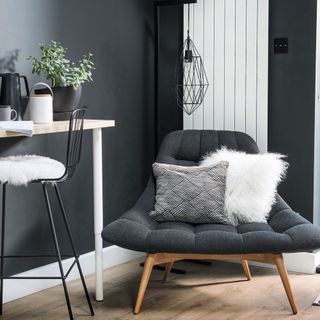
(Image credit score rating: Future PLC/Colin Poole)
8. Repeat for each radiator
Now that the first radiator is balanced, it’s possible you’ll then switch on to the next – after which repeat the strategy for each radiator. And whereas this sounds favor it’ll take you hours, you’ll shortly get into the flow into of points and shortly get proper right into a rhythm.
Nick accomplished by saying, ‘You’ll discover that this solves the problem and all radiators are reaching the right temperature. If not, it’s time to contact educated.’
‘Optimistic-tuning is also necessary. Be affected particular person, modify slowly, and keep measuring to verify a balanced system,’ explains Rob.
FAQs
What is the quickest resolution to steadiness your radiators?
Sadly, balancing your radiators isn’t a quick and easy job – significantly in the event you want to you’ll want to do it appropriately. This course of will likely be time-consuming, nonetheless how prolonged it takes lastly depends on how large your individual house is and what variety of radiators you may need.
Nevertheless to complete this job as shortly and successfully as potential, it’s essential to make adjustments to the lockshield valves. This often means closing the valves barely on radiators that heat up shortly and opening them up further for radiators that heat up slower.
How do I do know if my radiators are balanced?
The one resolution to know in case your radiators are balanced is to walk spherical your individual house, making a discover of how prolonged your radiators take to heat up and the way in which scorching they’re after they attain full temperature. You’ll often uncover that the radiator closest to your boiler will heat up the quickest and be the most well-liked.
The truth is, you may moreover go spherical your individual house with a digital thermometer to make this course of far more right.
Do I would really like a plumber to steadiness my radiators?
Specialists all agree it might be a simple adequate job to steadiness your radiators your self. Nonetheless, whether or not or not or to not title a plumber to do it for you all depends on the pipework you might be dealing with.
‘In case your heating system is fairly easy and in addition you don’t have very earlier or sophisticated pipework, DIY is manageable,’ explains Nick Duggan, Managing Director, The Radiator Centre. ‘You’ll need devices like a radiator key, lockshield valve adjuster and a thermometer. Balancing radiators can take a couple of hours (counting on the size of your system) so in case you’re prepared for that, it’s achievable.’
‘It’s a straightforward course of, primarily requiring endurance and a highlight to factor. The truth is, in case you’re unsure or uncomfortable with coping with heating components, or in case your system is further sophisticated, educated plumber or heating engineer can undoubtedly help,’ supplies Rob Nezard, Managing Director at UKRadiators.com.
Take this as your sign to steadiness your radiators in the event you want to keep away from losing money this winter.


